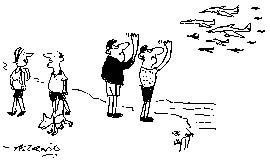I found myself in a fine pickle trying to give my email address on the telephone in Spanish. It was bad enough with W, an uncommon letter in Spanish. They have their own version of Alpha, Bravo, Charlie (or Able, Baker, Charlie for older readers), but I didn’t know it. Whisky for W seemed to work, but I dried up when it came to the @ sign.
The newly useful @ sign is called apestaartje, ‘little monkey’s tail’ in Dutch, and Germans follow suit. It is chiocciola, ‘snail’ in Italian, and a snail is also apparently what Koreans name it after. The Danes and Swedes liken it to an elephant’s trunk, but the Norwegians think of it as a pig’s tail.
The Spanish for ‘at’ is a, but a is also the name for the letter A. At last a nice friend of Veronica’s tells me that the Spanish for @ is arroba. I asked: ‘What does that mean?’ If I had asked that of a Frenchwoman, who would call @ arobase, she would have answered, ‘It just means that sign in email addresses.’
In Spanish, though, it had a meaning already, a measure of weight, a quarter of a quintal. If that sounds obscure, remember that quintal is an English word too, pronounced kwintl, formerly meaning ‘100lb’, later ‘a hundredweight’, which schoolgirls of my generation learnt was 112lb or a 20th of a ton. That means that an arroba is the same as our quarter: two stone or 28lb. Both the Spanish and the English words quintal come from Arabic, qintar. The dear old Arabs got that word from Latin. They borrowed lots of words from Latin, and qintar came from centenarium. From the same Latin word, we English derived centenary, a measure of weight as well as of years. (The Oxford English Dictionary gives the ‘regular’ pronunciation with the stress on the first syllable, which no one uses today.)
On a website called Purnas, partly devoted to the Aragonese language (there is such a thing), I found a learned article proving that the earliest use of the @ sign for arroba was not in Seville in 1536, as someone claimed last year. An example is given from a document written in 1448 in the Aragonese town of Ariza, recording a shipment of wheat.
Although arroba comes from the Arabic ar-rub, ‘a quarter’, modern-day Arabs call @ by the Arabic word fi, meaning ‘at’ — and ‘in’, ‘on’, ‘near’, ‘by’, ‘to’ or ‘times’, as in multiplication — which is a sort of correlative of ‘@’.






Comments